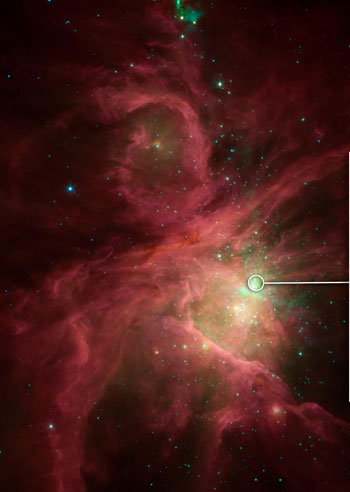
An infrared image of the Orion Nebula; the circled area shows the region where shocks and emission from molecular oxygen are found. Credit: ESA/NASA/JPL-Caltech
Newly published research from the Harvard-Smithsonian Center for Astrophysics provides the first self-consistent treatment of preshock, shock, and postshock regions under the influence of UV fields, and explains why O2 detections are so rare.
Oxygen is the third most abundant element in the universe (after hydrogen and helium) and of course it is important: all known life forms require liquid water and its oxygen content. For over thirty years, astronomers have been searching for molecular oxygen, O2, as part of an accounting of cosmic oxygen atoms. Despite early predictions that O2 should be abundant in the molecular clouds that form new stars and planetary systems, it is virtually absent. Only two locations have convincing O2 detections, a region of shocks near the Orion Nebula, and a cloud in the constellation of Ophiuchus. The theory is clearly wrong. What is not clear is whether O2 is missing (with dramatic implications for its abundance and the chemistry of molecular clouds), is in some less detectable form (perhaps frozen onto dust grains), or has been taken up to form water, carbon monoxide, or other oxygen-bearing molecules.
The launch of the Herschel Space Observatory enabled much more sensitive searches for O2, and prompted updated chemical modeling for molecular clouds and their oxygen. CfA astronomer Gary Melnick and his colleague improved the models to take into account the role of ultraviolet radiation in modifying the chemical and physical conditions in shocks. Their goal was to explain the strength and proportions of the line emission in Orion, and to understand what made the Orion environment so special.
The scientists report that when UV illuminates the region of a shock, the width and temperature of the shocked region changes, and enhances the O2 in two ways: by knocking oxygen off dust grains and breaking apart some molecules, thus increasing the number of free atoms before the shock, and by breaking apart water in the post-shock gas so that more O2 can form. The new model also successfully resolves the outstanding puzzle about its limited detection, finding that the detectability is very sensitive to the size and geometry of the emitting region. The paper provides the first self-consistent treatment of preshock, shock, and postshock regions under the influence of UV fields, and explains why O2 detections are so rare.
Reference: “O2 Emission toward Orion H2 Peak 1 and the Role of FUV-illuminated C-shocks” by Gary J. Melnick and Michael J. Kaufman, 19 June 2015, The Astrophysical Journal.
DOI: 10.1088/0004-637X/806/2/227
arXiv: 1505.03909

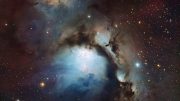

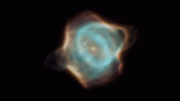
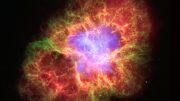
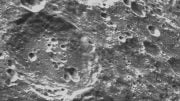
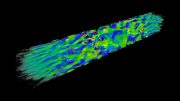
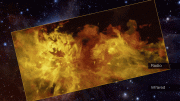
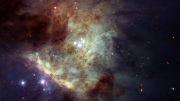
Be the first to comment on "Astronomers Develop New Models to Search for Molecular Oxygen"